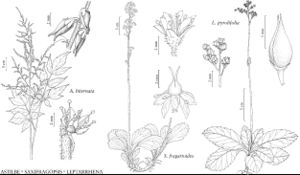Leptarrhena
Chlor. Melvill., 15. 1823 ,.
Herbs rhizomatous, not stoloniferous; caudex scaly, not cormlike, with persistent leaf-bases. Flowering-stems ascending or erect, leafy, (8–) 15–35 (–48) cm, glabrous proximally, puberulent and stipitate-glandular distally. Leaves in basal rosette and cauline; basal leaves marcescent; cauline leaves 1–4, clasping, smaller distally; stipules inconspicuous, adnate to petiole; petiole absent in cauline leaves, present in basal, glabrous; blade obovate to elliptic, unlobed, base tapered, ultimate margins crenate-serrate, sometimes entire in cauline leaves, apex obtuse or rounded, surfaces glabrous or sparsely glandular abaxially; venation pinnate. Inflorescences compound cymes, terminal from terminal bud of rosette, (18–) 26–100-flowered, bracteate. Flowers: hypanthium adnate to proximal 1/4–1/2 of ovary, free portion absent, green proximally, usually purplish distally; sepals 5, greenish; petals 5, white; nectary disc absent; stamens 10; (anthers dehiscent by broad, terminal openings); filaments linear; ovary 1/4–1/2 inferior, 2-locular, carpels connate proximally; placentation axile; styles 2; stigmas 2. Capsules folliclelike, 2-beaked. Seeds yellowish-brown or tan, shiny, fusiform, ribbed (at least over embryo). x = 7.
Distribution
nw North America
Discussion
Species 1: nw North America.
R. J. Gornall (1985) reviewed the nomenclature of Leptarrhena. Based on molecular data, D. E. Soltis et al. (1993) placed it and the Asian, monospecific Tanakaea Franchet & Savatier sister in a group also including Boykinia, Jepsonia, Sullivantia, and Telesonix. Anther dehiscence in Leptarrhena and Tanakaea, which is by broad, terminal openings as opposed to longitudinal slits, appears to be unique in Saxifragaceae (H. G. A. Engler 1930). Soltis (1984d) found the karyotype of Leptarrhena to be distinct within the family.
Species 1
Selected References
None.
Lower Taxa
"full" is not a number.
